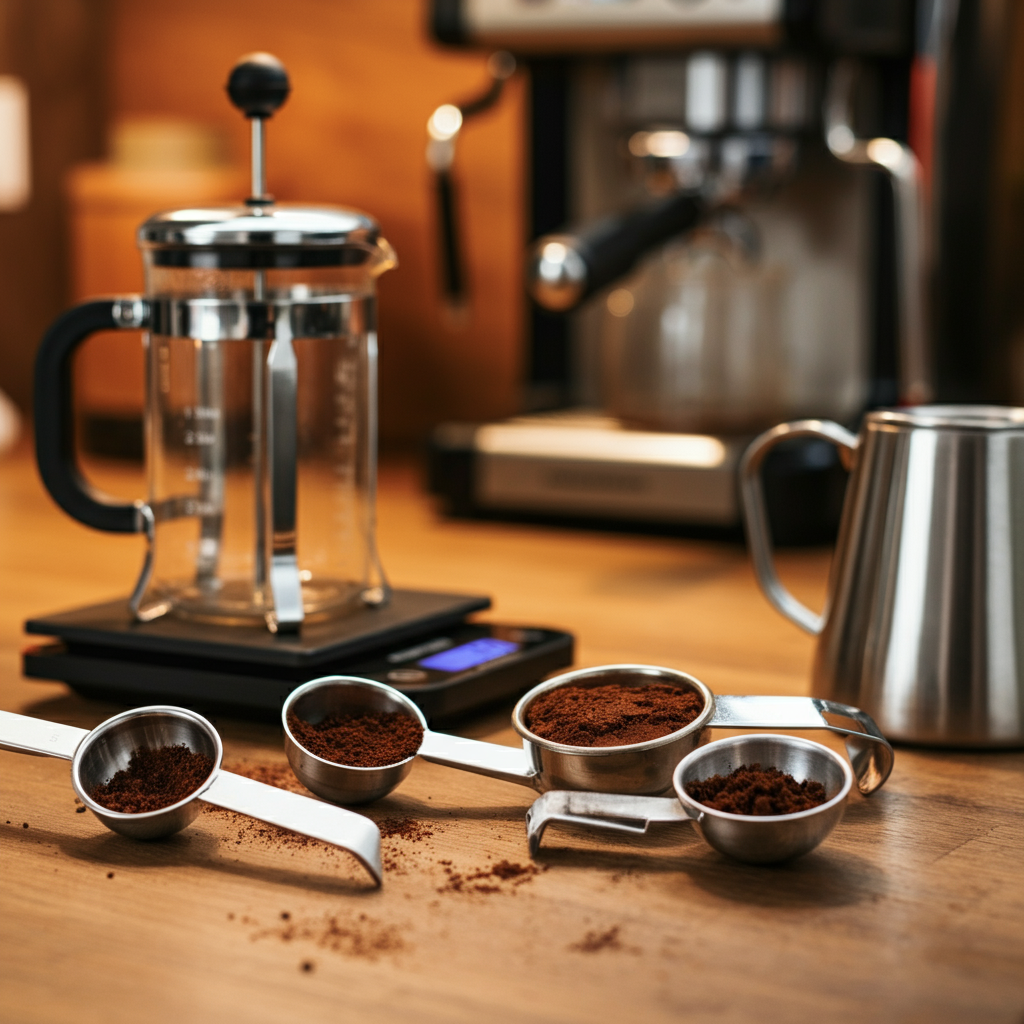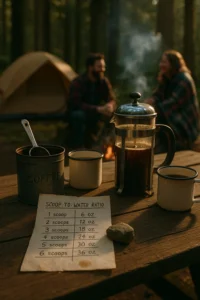Home » Coffee Knowledge » home-brewing » How Many Scoops of Coffee Per Cup?
Back when I first started behind the coffee bar, I thought making a good cup was just about scoops. More scoops? Stronger coffee. Fewer scoops? Milder brew. If I was feeling fancy, I might have eyed up those little plastic scoops that came with every gadget, blissfully unaware that every scoop in my drawer was a different size. Sound familiar?
Scoops can work in a pinch. But if you care even a little about consistency and flavor, grams will change everything. Trust me, those first mornings measuring coffee on a tiny scale opened up a world of difference in the cup. This blog will break down everything you want to know about scoops of coffee per cup, coffee scoop to water ratio, grams of coffee per cup, and more. You’ll get a practical, barista-approved coffee measurement guide and nuanced advice on coffee ratio by brew method. By the time you finish, you’ll be brewing with confidence, whether you’re at home or out camping with just a battered plastic scoop.

The coffee-to-water ratio is simple at its core but incredibly impactful on the final flavor of your brew. Too much coffee, and you’re left with an overly bitter, overpowering cup. Too little, and you might find your coffee watery or lacking complexity. The right balance highlights the nuanced flavors in your coffee beans and delivers a well-rounded drink.
Many experienced baristas follow the golden ratio, which is roughly 1–2 tablespoons of coffee for every 6 ounces of water. This can be a good starting point, but if you want precision, a scale is your best friend. Measuring coffee in grams rather than relying on scoops ensures consistency and gives you control over your brewing process.
Need more details on finding the perfect balance? Check out What is the Best Ratio for Making Coffee for an in-depth guide to coffee-to-water proportions.

For years, people talked about the “golden” coffee scoop to water ratio. Here’s how that often breaks down:
Quick reference table for coffee measurement:
Cup Size | Scoops | Grams of Coffee | Water (oz) |
|---|---|---|---|
1 cup | 1 scoop | 10g | 6 oz |
8 oz mug | ~1.3 scoops | ~13g | 8 oz |
12 oz large cup |
| 18–20g | 12 oz |
16 oz tumbler |
| 27g | 16 oz |
Is it perfect? Far from it. Water absorption, grind size, and even your perception of “level” scoops throw off the result. But it’s a starting place.
The digital scale is the barista’s best friend and the secret tool for brewing better at home. It’s not about being fussy; it’s about dialing in the exact experience you want, every single time.
Why scales matter:
How to measure coffee like a pro:
 Don’t worry, scoops still have a place in the wild. I use scoops constantly when camping with friends or making quick coffee at a mate’s place. They’re the ultimate backup plan.
Don’t worry, scoops still have a place in the wild. I use scoops constantly when camping with friends or making quick coffee at a mate’s place. They’re the ultimate backup plan.
Scoops work best:
Quick scoop-to-water chart:
Water (oz) | Level Scoops | Notes |
|---|---|---|
6 | 1 | Standard mug |
12 | 2 | For larger mugs |
24 | 4 | French press, group |
Always use level, not heaping, scoops! |
Pro tip: If you’re in a rush, fill your scoop evenly and scrape excess off to keep each one the same. Consistency is the secret sauce.
Most people adjust coffee strength the wrong way. If your cup is too weak, don’t just add more water—that makes it more bitter and flat. Instead, bump up the coffee by a few grams. Want it lighter? Use a bit less coffee, not more water.
Looking for methods to brew coffee that’s bolder? Check out How to Make Strong Coffee at Home for actionable advice on crafting a stronger cup.
Experiment with ratios:
The real fun in coffee is the tinkering. Take notes, nudge things up or down, and soon you’ll know exactly how to make coffee that matches your mood.
No two brewing methods treat scoops or water quite the same. Here’s a cheat sheet that covers the most popular methods, the coffee ratio by brew method, and which measurement guide works best:
Pour-over brewing is ideal for precision. It offers immense control over each step, from grind size to water distribution. For a deep-dive into mastering your pour-over, check out The Ultimate Guide to Single Drip Coffee Pour Over.
Working the bar, I’ve watched people make the same coffee blunders over and over:
Small changes here will give you a better cup every single day.
Coffee should be approachable, not intimidating. Start simple. If all you have is a scoop, use the golden guide, and pay attention to your taste. But investing in a $10 digital scale is the single best move a home brewer can make. It’s the moment a mug of coffee becomes your ritual, a daily experiment you get better at with every cup.
Find the ratio and method that match your mood, your beans, and your lifestyle. Consistency is your friend—but don’t forget to experiment and keep it fun. After all, the secret to great coffee isn’t a scoop, a scale, or even the fanciest gear. It’s the care you put into every cup.
Happy brewing, friends.
SHARE THIS RECIPE

Welcome to Coffee Slang—I’m Nick Puffer, a former barista turned coffee enthusiast. What started behind the counter became a passion I now share with others. Join me as we explore the craft, culture, and lifestyle of coffee.
We care a lot about the experience you have with coffee. A lot of work has gone into getting great beans to your door.
Get Updates From Us When We Create New Ways To Explore Coffee!